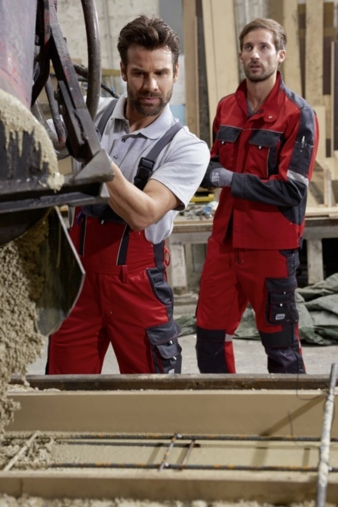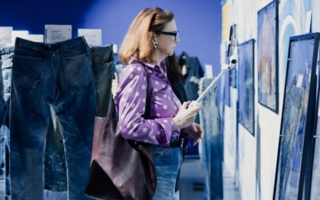15/07/2019 – A+A — auf Deutsch lesen
When Used Bottles turn into Corporate Fashion
Protection and chic are minimum required considered for corporate fashion, but there have also been many developments in fit and sustainability.

Personalisation is considered a key trend. This is why an ever wider choice of colours is offered. “This allows garments and colour versions of the collection to be perfectly coordinated thereby producing a very tailor-made company appearance. We also supply the apparel with company logo and employee name,” says Michael Stielow, Product & Marketing Lead DACH at CWS. © CWS-boco
Susen Lemnitzer, Head of PM and Development for Workwear at Uvex:
“There is more to feeling good than just good looks. At work people want to feel just as good as they do anywhere else.”
Playing an especially prominent role here are the next-to-skin materials but high demands are also made on the outer layer. This protects from wind, moisture and heat, makes for improved temperature control and is as lightweight as possible yet still highly resistant.
Carla Cacitti, Head of PM and Development at Bierbaum Proenen (BP):
“It is easy to see why staff would make increasing demands on their workwear. After all they wear their workwear between eight and ten hours a day.”
Be in Demand and Boast Expertise
Boiler suits and smocks have now become fashionable, functional outfits. Working jackets are replaced by sweaters, knits, utility jackets and hoodies in a layered look. Inspired by sports and leisure plus the rising expectations and the growing self-confidence of competent professionals, workwear specialists develop emotional products that deliver more and more performance. They are functional, send out a message of expertise, underpin a community feel, foster a “we-are-needed attitude” and are in line with the current zeitgeist. And this is why people like to wear them – not only at the workplace.
A key factor boosting the popularity of workwear is the fact that employees are fitted out all year round.
Joachim Geyer, Kübler:
„Our Reflectiq Line encompasses complete packages in four colour combinations. These include shorts, summer slacks, high-visibility shirts with UV protection and jackets with membranes for winter.”
At BP vests are coordinated with soft-shell and fleece jackets. “This allows wearers to flexibly and swiftly react to any sudden weather changes.” The layered look does the rest. It is handy because different trades come with different physical strains and, apart from that, each wearer has a subjective perception of heat levels.
Wear Comfort and Freedom of Movement are Trumps
Materials and fits have been developed above all to improve wear properties while retaining protection levels. “Lightweight, soft and yet rugged and hard-wearing,” are the attributes of these new workwear materials. By BP’s accounts, cotton continues to enjoy major popularity. At the same time, they say, wearers also call for all types of utility fabrics such as stretch or fleece fabrics “that are synonymous with a high degree of freedom of movement.” Mesh panels in jackets and pants help to cool wearers in the summer months while Cordura inserts protect knees, pockets or other parts of the garments exposed to high strain.
Lighter weight materials also help to optimise the fit. Supported by 3D measuring methods and the implementation of their results the focus is on movement patterns overall rather than individual body positions such as overhead work and working on knees. Ergonomic cuts are designed to ensure as much freedom of movement as possible despite the rather skinny “modern-fit” silhouettes.
Smart Functionality – also for Designer Beards
Reflective piping and stripes are used as styling and protective elements. Explaining the hi-vis collection Geyer says: “The Reflectiq products are eye-catching, if only through their array of reflective elements. These follow ‘body-language’ lines emphasising body contours and accelerating the identification of wearers as human beings. Additional reflective stripes on the shoulders improve visibility when carrying objects or working in a bent position.”
The collars are lined with fleece materials inside and trimmed with fabric to ensure wear comfort and freedom of movement also for wearers with a designer beard. Heat can be dissipated better by under-arm venting. Storm hoods can be adjusted individually both on the left and right-hand side so that the field of vision is not compromised when wearers turn their heads. Sporty stripes and colour contrasts give wearers an athletic silhouette.
Subdued Colours increase Perceived Value
Personalisation is considered a key trend. This is why an ever wider choice of colours is offered.
Michael Stielow, Product & Marketing Lead DACH at CWS:
“This allows garments and colour versions of the collection to be perfectly coordinated thereby producing a very tailor-made company appearance. We also supply the apparel with company logo and employee name.”
Anthracite, black and olive have now emerged as competitors for blue and red. The colours are more subdued and produce a higher-quality impression. White-washers no longer have to show up in white and gardeners do not necessarily have to wear green. It is rather corporate design and corporate colours that take centre stage these days.
Thomas Lange of German Fashion:
“Be it men or women, the demands made especially on imagewear are no longer gender specific. Fit, quality and functionality always correspond to highest requirements.”
Wear properties and looks play an equally important role for all employees. Manufacturers now come up with completely new styles for women in addition to unisex garments rather than just adapting men’s styles to female fits. Companies such as BP, Blakläder and Kübler have noticeably extended their colour range for the NOS line in response to the “Workwear for Women” mega trend. “Also key is a wide selection of sizes,” says Geyer. Digital systems are especially helpful for creating the patterns and cutting special sizes – which is of particular interest for tall employees.
Digitalisation also Promotes Sustainability
Digitalisation has made workwear sourcing a lot easier – regardless of size, gender and trade. Employees can place orders round the clock, manage their customer account and find comprehensive information on the website. Deliveries are made from fully automated warehouses in no time. This type of order handling also minimises errors. Back office and field service staff have more time to focus on service and customers.
“Digitalisation revolutionises all sectors of this industry – from planning and sourcing to logistics,” explains Lange who goes on to say: “In product development you can have a look at the virtual products before the first samples are manufactured. Pre-calculations show the costs prior to development. Sourcing platforms maintained with suppliers as well as the improved data exchange cut lead times and inventories.” All of which also helps the sector’s sustainability.
To customise the sustainability message for customers Uvex talks about the various options for developing sustainable clothing concepts from the outset. “This includes a selection of sustainably produced materials and raising awareness for resource-saving production processes, for instance by layer optimisation,” explains Lemnitzer.
Circular Economy: PET Bottles Become Jackets
However, the commitment to ethical business, environmental protection and resource-saving processes is anything but new in this industry. Several companies have already been members of the Fair Wear Foundation for years. In terms of harmful substances REACH and Ökotex provisions set the standards. “We discuss with our suppliers the impact of our operations on all levels of the value chain to continuously improve these,” says BP. Workwear specialists are members of Fairtrade Cotton and are Step, Bluesign and/or SA 8000 certified. They are members of such organisations as amfori BSCI, Bündnis für nachhaltige Textilien etc. or bear the Gots seal. Kübler, for example, is also certified according to ISO 9001 (Quality Management) and ISO 14001 (Environmental Management).
“The most important contribution to sustainability is the quality of products because their longevity saves resources and reduces energy consumption,” says Cacitti and Lange adds: “Companies acting as suppliers for public customers are in any case confronted with sustainability requirements in invitations to tender. Furthermore, many local authorities have already embedded such requirements in their tenders.”
At the forthcoming A+A 2019 BP will launch a workwear collection primarily made from recycled plastic bottles which, beyond this, also sets new standards in terms of wear comfort.
Kirsten Rein
A+A 2019, Düsseldorf
05.–08. November 2019




